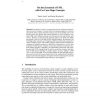Free Online Productivity Tools
i2Speak
i2Symbol
i2OCR
iTex2Img
iWeb2Print
iWeb2Shot
i2Type
iPdf2Split
iPdf2Merge
i2Bopomofo
i2Arabic
i2Style
i2Image
i2PDF
iLatex2Rtf
Sci2ools
UML
2000
Springer
2000
Springer
On the Extension of UML with Use Case Maps Concepts
Descriptions of reactive systems focus heavily on behavioral aspects, often in terms of scenarios. To cope with the increasing complexity of services provided by these systems, behavioral aspects need to be handled early in the design process with flexible and concise notations as well as expressive concepts. UML offers different notations and concepts that can help describe such services. However, several necessary concepts appear to be absent from UML, but present in the Use Case Map (UCM) scenario notation. In particular, Use Case Maps allow scenarios to be mapped to different architectures composed of various component types. The notation supports structured and incremental det of complex scenarios at a high level of abstraction, as well as their integration. UCMs specify variations of run-time behavior and scenario structures through sub-maps "pluggable" into placeholders called stubs. This paper presents how UCM concepts could be used to extend the semantics and notatio...
| Added | 25 Aug 2010 |
| Updated | 25 Aug 2010 |
| Type | Conference |
| Year | 2000 |
| Where | UML |
| Authors | Daniel Amyot, Gunter Mussbacher |
Comments (0)

